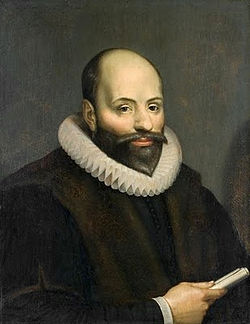
William Burnes or William Burness was the father of the poet Robert Burns. He was born at either Upper Kinmonth or Clochnahill Farm, Dunnottar, Kincardineshire, and trained as a gardener at Inverugie Castle, Aberdeenshire, before moving to Ayrshire and becoming a tenant farmer. His parents were Robert Burnes and Isabella Keith. He retained the spelling 'Burnes' throughout his life; however, his son favoured the Ayrshire spelling of 'Burns'.

Gilbert Burns, the younger brother of Robert Burns the poet, was born at Alloway. He married Jean Breckenridge in 1791, had six sons and five daughters, died in 1827, aged 66, and was buried at Bolton, East Lothian, Scotland. Gilbert's writings have contributed greatly to the bank of knowledge that exists regarding the life of his famous brother.

The Hermitage was a folly first built by Captain Robert Riddell of Friars Carse as part of his enthusiasm for antiquities. It is famous for its connection with the bard Robert Burns who through his friendship with Riddell was permitted to use it to compose poetry in this secluded and tranquil sylvan spot. Burns also used his diamond point pen to engrave lines on the window pane at the Hermitage following the premature death of Riddell. The original Hermitage fell into disrepair and was rebuilt in 1874. It was further restored to its former glory more recently (2009).

Poems, Chiefly in the Scottish Dialect is commonly known as the first Edinburgh Edition and the partial second setting has become known as the Stinking Edition. It is a collection of poetry and songs by Robert Burns, first "Printed for the Author" by William Smellie in Edinburgh and published or "Sold by William Creech" of Edinburgh on the 17 April, an announcement being made in the Edinburgh Advertiser on that date, although the date 21 April 1786 is given by a few authors. The Kilmarnock Edition made Robert Burns Caledonia's Bard whilst the 'Edinburgh Edition' elevated him into a position amongst the world's greatest poets.
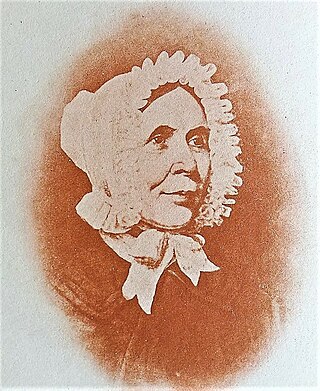
Isabella Burns (Isabella Begg) (1771–1858) or Isobel Burns (Isobel Begg) was the youngest sister of the poet Robert Burns, born to William Burness and Agnes Broun at Mount Oliphant Farm on the 27 June 1771 and christened on 2 July 1771 by Rev. William McGill, a friend of her father. When she died she was the last member of Robert Burns's immediate family and when living at Bridge House in Alloway for the last sixteen years of her life she entertained many visitors who were interested in his life and works. She was the source of many published insights into Burns' life, character and loves. Her siblings knew her as 'Isbal'.

The Glenriddell Manuscripts is an extensive collection written in holograph by Robert Burns and an amanuensis of his letters, poems and a few songs in two volumes produced for his then friend Captain Robert Riddell, Laird of what is now Friars Carse in the Nith Valley, Dumfries and Galloway. The two volumes of the manuscript were handsomely bound in calf leather. The first volume of poems and songs was completed by April 1791 and was presented to Robert Riddell, however their friendship ceased due to the unfortunate 'The Rape of the Sabine Women' incident and Robert Riddell died shortly after before any reconciliation could take place. The first volume is partly in Burns's hand with one main amanuensis contributing much of the text in a far neater hand than the author himself and a possible third person contributing to the text. The second volume is entirely in Burns's hand.

Robert Burns's Commonplace Book 1783–1785 is the first of three commonplace books that were produced by the poet. The contents cover drafts of songs and poems, observations, ideas, epitaphs, etc.
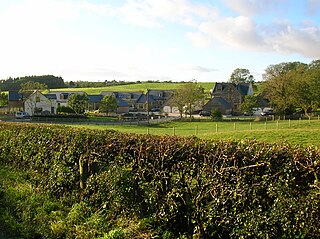
Handsome Nell was the first song written by Robert Burns, often treated as a poem, that was first published in the last volume of James Johnson's Scots Musical Museum in 1803 (No.551) with an untitled tune. Burns recorded in holograph on page three of his first Commonplace Book that he wrote the song or Rhyme at the age of only fifteen whilst living at Mount Oliphant Farm, it is regarded as his earliest production, inspired by a farm servant aged fourteen, named either Nelly Kilpatrick or Nelly Blair. Some confusion exists as he also gave his age as 16 in his autobiographical letter to Dr. Moore; the autumn of 1774 is generally accepted.
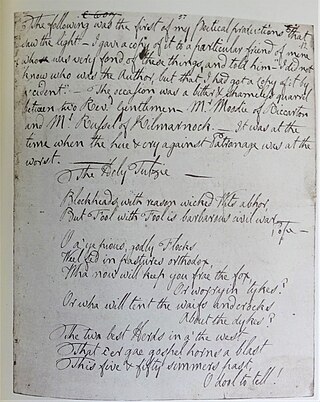
'The Holy Tulzie', 'The Twa Herds' or 'An Unco Mournfu' Tale was a poem written in 1784 by Robert Burns whilst living at Mossgiel, Mauchline, about a strong disagreement, not on doctrine, but on the parish boundaries, between two 'Auld Licht' ministers, John Russel and Alexander Moodie It was followed by "The Holy Fair", "The Ordination", "The Kirk's Alarm", "Holy Willie's Prayer", etc.
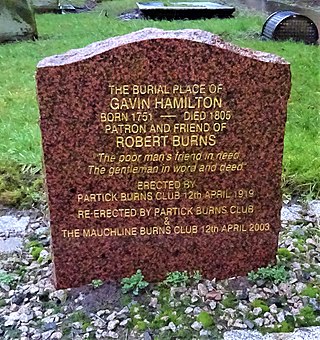
Gavin Hamilton was one of Robert Burns's closest friends and a patron. The first 'Kilmarnock Edition' of his poems were dedicated to Gavin Hamilton.

John Richmond (1765–1846) was one of Robert Burns's closest friends and confidants. He was born in Sorn parish at Montgarswood, Ayrshire, Scotland. His father, Henry Richmond, was a merchant in Mauchline and owned Montgarswood Farm that lies near Sorn. This farm passed to James, John's brother, having once been farmed by William Fisher, Burns's Holy Willie.

James Smith of Mauchline was one of Robert Burns's closest friends and confidants. He was born in 1765, son of a Mauchline merchant, Ayrshire, Scotland. In 1775, when he was only ten years, old his father, Robert Smith, a prosperous local merchant, was killed in a riding accident, falling from his horse whilst returning from Ayr. His mother, Jean Smith, remarried James Lamie who owned the adjoining house.

John Murdoch of Ayr was Robert Burns's most significant teacher or tutor and he was a friend of the Burnes family. He was born in 1747 and first taught Gilbert and Robert Burns in Alloway when he was only aged eighteen. He remained in contact with the Burnes family for several years after leaving Ayrshire for London. Murdoch, William Burnes and Richard Brown were amongst the most significant influences on Burns life during his early years in Ayrshire.

John Ballantine (1743–1812), was a Scottish merchant and banker and one of the greatest friends, admirers and closest confidants of Robert Burns. Significantly Ballantine gave the poet advice on the selection of poems for his First Kilmarnock Edition as well as being asked for his opinion on the bard's poems.

Robert Ainslie (1766–1838) was a Scottish lawyer, and one of Robert Burns's long-term friends from his Edinburgh days. He was probably the closest confidant of Burns, whom he met first at a Masonic or Crochallan Fencibles event. Ainslie accompanied the poet on the first part of his Border Tour. Robert's father, also Robert, was a lawyer a bailie at Duns and a land-steward on Lord Douglas's Berwickshire estates. Robert married Jean Cunningham on 22 December 1798.
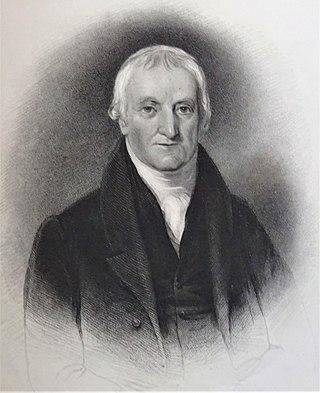
John Syme was a Scottish lawyer and one of the poet Robert Burns's closest friends during his time in Dumfries. In the summers of 1793 and 1794 he joined Burns on his two short tours of Galloway. Syme and Alexander Cunningham were amongst the most active of the friends and admirers of Burns's works who raised funds for the poet's family and for his mausoleum with the assistance of others such as James Currie. Together with Dr Willam Maxwell he arranged Burns's funeral.

The Geddes Burns is a copy of Robert Burns's 1787 Poems, Chiefly in the Scottish Dialect with twenty-seven extra pages with twelve poems and songs in Burns's handwriting bound in, and a letter to Catholic Bishop John Geddes from the poet, written at Ellisland Farm.
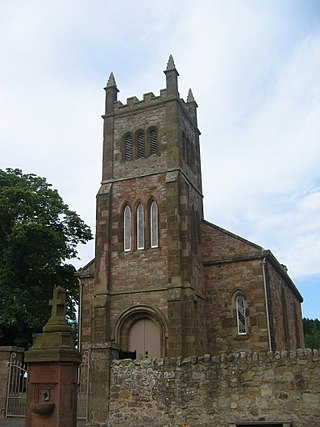
Annabella Burns or Nannie Burns (1764–1832) was the second oldest sister of the poet Robert Burns, and the last child born to William Burness and Agnes Broun whilst at the Alloway cottage. She was born on the 14 November 1764 and she was christened on 17 November by Rev. William Dalrymple, the minister of Ayr Parish Church. When she died in 1832 she was the last member of Gilbert Burns's household at Grant's Brae to be buried at the Bolton Kirk family lair. Gilbert Burns had died, also aged 67, five years earlier in 1832.

John Burns (1769–1785) was the youngest brother of the poet Robert Burns and the last son born to William Burness and Agnes Broun. John was born at Mount Oliphant Farm on the Doonholm Estate near Alloway on the 12 July 1769. He was christened circa 21 July 1769 by Rev. Rev William Dalrymple.

William Burns (1767–1790) was the second youngest brother of the poet Robert Burns and the third son born to William Burness and Agnes Broun. William was born at Mount Oliphant Farm on the Doonholm Estate near Alloway, about three miles from Ayr, on the 12 July 1769. He was christened circa 6 August 1767 by the Rev. Rev William Dalrymple of Ayr parish and kirk.


